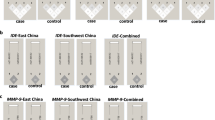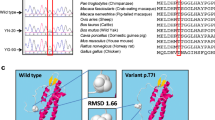Abstract
Amyloid precursor protein (APP) is cleaved by β-secretase and γ-secretase complex, and subsequently generates amyloid-β peptide (Aβ). The Aβ cascade is widely accepted as playing a role in the pathogenesis Alzheimer’s disease (AD). Meanwhile, procession of APP by α-secretase (mainly a disintegrin and metalloproteinase 10, ADAM10) precludes Aβ production, and produces soluble APP-α which is considered to be neuroprotective against AD. To explore the relationship between APP, ADAM10 gene polymorphism and sporadic AD (sAD), we conducted a case–control study in a Chinese Han cohort including 200 sAD patients and 243 control participants. Four target single nucleotide polymorphisms (SNPs) in or near the promoter of the APP gene and two in the promoter of the ADAM10 gene were selected and genotyped with a polymerase chain reaction–ligase detection reaction method. After adjustments for age, sex, and APOE ε4 status, only one target SNP, rs463946 was associated with the risk of sAD in the dominant (OR 1.52, 95 % CI 1.01–2.29, P = 0.045) and overdominant models (OR 1.59, 95 % CI 1.04–2.43, P = 0.031); the results also showed a borderline association of rs364048 (OR 1.53, 95 % CI 1.00–2.34, P = 0.048) and rs466433 (OR 1.53, 95 % CI 1.00–2.34, P = 0.048) with the risk of sAD in the overdominant model. However, these associations did not remain after multiple comparison correction. As for the ADAM10 gene, the two target SNPs (rs514049 and rs653765) were not associated with the risk of sAD either. No significant association was found between different haplotypes of the two genes and the risk of sAD. Conclusively, we did not find the association between APP, ADAM10 gene polymorphism, and the risk of sAD in our cohort of Chinese Han people.

Similar content being viewed by others
References
Barrett JC, Fry B, Maller J, Daly MJ (2005) Haploview: analysis and visualization of LD and haplotype maps. Bioinformatics 21:263–265
Bekris LM, Galloway NM, Millard S, Lockhart D, Li G, Galasko DR, Farlow MR, Clark CM, Quinn JF, Kaye JA, Schellenberg GD, Leverenz JB, Seubert P, Tsuang DW, Peskind ER, Yu CE (2011) Amyloid precursor protein (APP) processing genes and cerebrospinal fluid APP cleavage product levels in Alzheimer’s disease. Neurobiol Aging 32:556 e513-523
Bekris LM, Lutz F, Li G, Galasko DR, Farlow MR, Quinn JF, Kaye JA, Leverenz JB, Tsuang DW, Montine TJ, Peskind ER, Yu CE (2012) ADAM10 expression and promoter haplotype in Alzheimer’s disease. Neurobiology of aging 33:2229 e2221–2229 e2229
Bertram L, Tanzi RE (2008) Thirty years of Alzheimer’s disease genetics: the implications of systematic meta-analyses. Nat Rev Neurosci 9:768–778
Bertram L, Lange C, Mullin K, Parkinson M, Hsiao M, Hogan MF, Schjeide BM, Hooli B, Divito J, Ionita I, Jiang H, Laird N, Moscarillo T, Ohlsen KL, Elliott K, Wang X, Hu-Lince D, Ryder M, Murphy A, Wagner SL, Blacker D, Becker KD, Tanzi RE (2008) Genome-wide association analysis reveals putative Alzheimer’s disease susceptibility loci in addition to APOE. Am J Hum Genet 83:623–632
Bettens K, Sleegers K, Van Broeckhoven C (2013) Genetic insights in Alzheimer’s disease. Lancet Neurol 12:92–104
Cavani S, Tamaoka A, Moretti A, Marinelli L, Angelini G, Di Stefano S, Piombo G, Cazzulo V, Matsuno S, Shoji S, Furiya Y, Zaccheo D, Dagna-Bricarelli F, Tabaton M, Mori H (2000) Plasma levels of amyloid beta 40 and 42 are independent from ApoE genotype and mental retardation in Down syndrome. Am J Med Genet 95:224–228
Colciaghi F, Borroni B, Pastorino L, Marcello E, Zimmermann M, Cattabeni F, Padovani A, Di Luca M (2002) [alpha]-Secretase ADAM10 as well as [alpha]APPs is reduced in platelets and CSF of Alzheimer disease patients. Mol Med 8:67–74
Donmez G, Wang D, Cohen DE, Guarente L (2010) SIRT1 suppresses beta-amyloid production by activating the alpha-secretase gene ADAM10. Cell 142:320–332
Gabriel SB, Schaffner SF, Nguyen H, Moore JM, Roy J, Blumenstiel B, Higgins J, DeFelice M, Lochner A, Faggart M, Liu-Cordero SN, Rotimi C, Adeyemo A, Cooper R, Ward R, Lander ES, Daly MJ, Altshuler D (2002) The structure of haplotype blocks in the human genome. Science 296:2225–2229
Hardy J, Selkoe DJ (2002) The amyloid hypothesis of Alzheimer’s disease: progress and problems on the road to therapeutics. Science 297:353–356
Hirayama A, Horikoshi Y, Maeda M, Ito M, Takashima S (2003) Characteristic developmental expression of amyloid beta40, 42 and 43 in patients with Down syndrome. Brain Dev 25:180–185
Hooli BV, Tanzi RE (2009) A current view of Alzheimer’s disease. F1000 Biol Rep 1:54
Hooli BV, Mohapatra G, Mattheisen M, Parrado AR, Roehr JT, Shen Y, Gusella JF, Moir R, Saunders AJ, Lange C, Tanzi RE, Bertram L (2012) Role of common and rare APP DNA sequence variants in Alzheimer disease. Neurology 78:1250–1257
Jones EL, Ballard CG, Prasher VP, Arno M, Tyrer S, Moore B, Hanney ML (2010) An intron 7 polymorphism in APP affects the age of onset of dementia in down syndrome. Int J Alzheimer’s Dis 2011:929102
Jonsson T, Atwal JK, Steinberg S, Snaedal J, Jonsson PV, Bjornsson S, Stefansson H, Sulem P, Gudbjartsson D, Maloney J, Hoyte K, Gustafson A, Liu Y, Lu Y, Bhangale T, Graham RR, Huttenlocher J, Bjornsdottir G, Andreassen OA, Jonsson EG, Palotie A, Behrens TW, Magnusson OT, Kong A, Thorsteinsdottir U, Watts RJ, Stefansson K (2012) A mutation in APP protects against Alzheimer’s disease and age-related cognitive decline. Nature 488:96–99
Kim M, Suh J, Romano D, Truong MH, Mullin K, Hooli B, Norton D, Tesco G, Elliott K, Wagner SL, Moir RD, Becker KD, Tanzi RE (2009) Potential late-onset Alzheimer’s disease-associated mutations in the ADAM10 gene attenuate {alpha}-secretase activity. Hum Mol Genet 18:3987–3996
Kuhn PH, Wang H, Dislich B, Colombo A, Zeitschel U, Ellwart JW, Kremmer E, Rossner S, Lichtenthaler SF (2010) ADAM10 is the physiologically relevant, constitutive alpha-secretase of the amyloid precursor protein in primary neurons. The EMBO journal 29:3020–3032
Lammich S, Kojro E, Postina R, Gilbert S, Pfeiffer R, Jasionowski M, Haass C, Fahrenholz F (1999) Constitutive and regulated alpha-secretase cleavage of Alzheimer’s amyloid precursor protein by a disintegrin metalloprotease. Proc Natl Acad Sci USA 96:3922–3927
Li J, Wang YJ, Zhang M, Xu ZQ, Gao CY, Fang CQ, Yan JC, Zhou HD, Chongqing Ageing Study, G (2011) Vascular risk factors promote conversion from mild cognitive impairment to Alzheimer disease. Neurology 76:1485–1491
Lv H, Jia L, Jia J (2008) Promoter polymorphisms which modulate APP expression may increase susceptibility to Alzheimer’s disease. Neurobiol Aging 29:194–202
Mattson MP, Cheng B, Culwell AR, Esch FS, Lieberburg I, Rydel RE (1993) Evidence for excitoprotective and intraneuronal calcium-regulating roles for secreted forms of the beta-amyloid precursor protein. Neuron 10:243–254
Miar A, Alvarez V, Corao AI, Diaz M, Alonso B, Martinez C, Calatayud MT, Menendez M, Moris G, Coto E (2011) Amyloid precursor protein gene (APP) variation in late-onset Alzheimer’s disease. J Mol Neurosci 45:5–9
Obregon D, Hou H, Deng J, Giunta B, Tian J, Darlington D, Shahaduzzaman M, Zhu Y, Mori T, Mattson MP, Tan J (2012) Soluble amyloid precursor protein-alpha modulates beta-secretase activity and amyloid-beta generation. Nat Commun 3:777
Postina R, Schroeder A, Dewachter I, Bohl J, Schmitt U, Kojro E, Prinzen C, Endres K, Hiemke C, Blessing M, Flamez P, Dequenne A, Godaux E, van Leuven F, Fahrenholz F (2004) A disintegrin-metalloproteinase prevents amyloid plaque formation and hippocampal defects in an Alzheimer disease mouse model. J Clin Investig 113:1456–1464
Rovelet-Lecrux A, Hannequin D, Raux G, Le Meur N, Laquerriere A, Vital A, Dumanchin C, Feuillette S, Brice A, Vercelletto M, Dubas F, Frebourg T, Campion D (2006) APP locus duplication causes autosomal dominant early-onset Alzheimer disease with cerebral amyloid angiopathy. Nat Genet 38:24–26
Schroeder A, Fahrenholz F, Schmitt U (2009) Effect of a dominant-negative form of ADAM10 in a mouse model of Alzheimer’s disease. J Alzheimer’s Dis 16:309–314
Selkoe DJ (2001) Alzheimer’s disease: genes, proteins, and therapy. Physiol Rev 81:741–766
Shulman JM, Chen K, Keenan BT, Chibnik LB, Fleisher A, Thiyyagura P, Roontiva A, McCabe C, Patsopoulos NA, Corneveaux JJ, Yu L, Huentelman MJ, Evans DA, Schneider JA, Reiman EM, De Jager PL, Bennett DA (2013) Genetic susceptibility for Alzheimer disease neuritic plaque pathology. JAMA neurology 70:1150–1157
Sole X, Guino E, Valls J, Iniesta R, Moreno V (2006) SNPStats: a web tool for the analysis of association studies. Bioinformatics 22:1928–1929
Song JH, Yu JT, Liu M, Yan CZ, Tan L (2011) Genetic association between ADAM10 gene polymorphism and Alzheimer’s disease in a Northern Han Chinese population. Brain Res 1421:78–81
Tanzi RE, Bertram L (2005) Twenty years of the Alzheimer’s disease amyloid hypothesis: a genetic perspective. Cell 120:545–555
Tippmann F, Hundt J, Schneider A, Endres K, Fahrenholz F (2009) Up-regulation of the alpha-secretase ADAM10 by retinoic acid receptors and acitretin. FASEB J 23:1643–1654
Zeng F, Zou H-Q, Zhou H-D, Li J, Wang L, Cao H-Y, Yi X, Wang X, Liang C-R, Wang Y-R, Zhang A-Q, Tan X-L, Peng K-R, Zhang L-L, Gao C-Y, Xu Z-Q, Wen A-Q, Lian Y, Zhou X-F, Wang Y-J (2013) The relationship between single nucleotide polymorphisms of the NTRK2 gene and sporadic Alzheimer’s disease in the Chinese Han population. Neurosci Lett 550:55–59
Acknowledgments
This work was supported by the National Natural Science Foundation of China (Grant No. 81200987; No.81470058; No.81401055) and the Natural Science Foundation Project of CQCSTC (Grant No. CSTC2010BB5029). The authors would like to thank Shanghai Genesky Bio-Tech Genetic Core Lab for assistance in genotyping techniques.
Conflict of interest
The authors declare no conflicts of interest.
Author information
Authors and Affiliations
Corresponding authors
Electronic supplementary material
Below is the link to the electronic supplementary material.
Rights and permissions
About this article
Cite this article
Zeng, F., Shen, C., Liu, YH. et al. Genetic Association Between APP, ADAM10 Gene Polymorphism, and Sporadic Alzheimer’s Disease in the Chinese Population. Neurotox Res 27, 284–291 (2015). https://doi.org/10.1007/s12640-015-9516-1
Received:
Revised:
Accepted:
Published:
Issue Date:
DOI: https://doi.org/10.1007/s12640-015-9516-1




